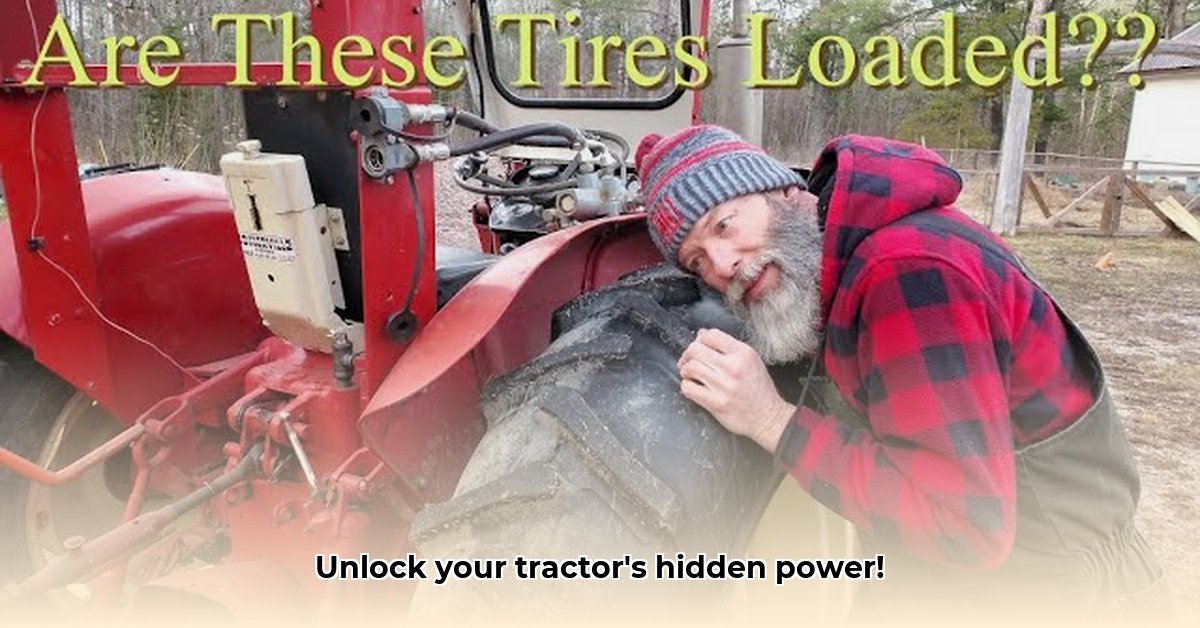
Choosing the Right Ballast for Your Tractor Tires
Getting the most from your tractor depends on optimal tire traction and stability. Ballasting your tractor tires is key, but choosing the right method impacts both performance and environmental sustainability. This guide compares various ballasting options, helping you select the best solution for your farm. For more information on ballast boxes, check out this helpful resource.
Water: The Budget-Friendly, But Frigid-Sensitive Option
Water is readily available and inexpensive. It’s easy to fill and drain, making it a convenient choice. However, water's low density means it may not provide sufficient weight for optimal traction, especially on hills or in challenging conditions. More importantly, water freezes solid at 32°F (0°C), rendering it impractical in cold climates. This freezing can also damage tires.
Pros: Inexpensive, readily available, easy to use.
Cons: Freezes easily, relatively lightweight, not suitable for all conditions, potential for tire damage from freezing.
Propylene Glycol: A Cold-Weather Champion
Propylene glycol antifreeze offers superior cold-weather performance. Its freezing point is significantly lower than water, remaining liquid even at sub-zero temperatures. It also provides greater weight than water, boosting traction and stability on uneven terrain. While more expensive than water, propylene glycol is a more environmentally friendly alternative to other antifreeze options, like ethylene glycol.
Pros: Low freezing point, environmentally friendlier than ethylene glycol, heavier than water, improved traction and stability.
Cons: More expensive than water.
Beet Juice: A Sustainable Alternative
Beet juice presents a surprisingly effective and sustainable ballasting option. It's a byproduct of sugar beet processing, making it a waste-reduction solution. Being biodegradable, it poses minimal environmental risks. Its performance is adequate in moderate climates, but its freezing point limits its use in extremely cold conditions.
Pros: Sustainable, biodegradable, relatively low environmental impact.
Cons: Higher cost than water, freezing point limits use in extremely cold climates, availability may vary.
Calcium Chloride: Proceed With Extreme Caution
Historically used for its extreme freeze resistance, calcium chloride is highly corrosive. It can severely damage tires and rims, leading to costly repairs and posing a significant environmental hazard due to soil contamination. Unless operating in exceptionally harsh, sub-zero conditions where all other options are unfeasible, avoid its use.
Pros: Extremely low freezing point.
Cons: Highly corrosive, damages equipment, significant environmental concerns, high risk of tire damage.
A Comparative Overview
The following table summarizes the pros and cons of each method:
| Ballast Type | Pros | Cons | Freeze Point (°F) |
|---|---|---|---|
| Water | Inexpensive, readily available, easy to use | Freezes easily, lightweight, unsuitable for challenging conditions, tire damage risk | 32 |
| Propylene Glycol Antifreeze | Low freezing point, environmentally friendly, good weight, improved stability | More expensive than water | -35 (50/50 mix) |
| Beet Juice | Sustainable, biodegradable, low environmental impact | Higher cost, limited use in extremely cold climates | -35 (approx.) |
| Calcium Chloride | Very low freezing point | Highly corrosive, damages equipment, significant environmental concerns, high risk of tire damage | -50 to -60 |
A Step-by-Step Guide to Choosing the Right Ballast
Choosing the ideal ballast involves several crucial steps:
Assess Your Climate: Do you experience freezing temperatures? This significantly limits your options. Water is unsuitable for cold climates.
Define Your Budget: Water is the cheapest; other options increase in cost.
Prioritize Sustainability: Favor environmentally friendly options whenever feasible. Beet juice and propylene glycol are preferable to calcium chloride or ethylene glycol.
Determine Your Weight Requirements: Consider the weight of your tractor and the tasks performed. Heavier ballasts provide greater stability and traction on challenging terrains.
Implement Regular Inspections: Regularly check ballast levels for leaks or evaporation, maintaining optimal tractor performance and preventing potential damage.
Expert Insight: Prioritizing Sustainability and Safety
"Choosing the right ballast is a critical decision for farmers," says Dr. Emily Carter, Agricultural Engineer at the University of California, Davis. "It influences not only your tractor's performance but also your environmental footprint and long-term costs. Prioritizing safety and making an informed choice aligned with your specific needs and climate is essential."
Looking Ahead: The Future of Sustainable Ballasting
Research continuously explores alternative ballasting materials. Organic options and innovative solutions are under investigation, promising more sustainable and efficient choices in the future. Keep up-to-date with relevant publications for the latest advancements. The right ballast balances short-term performance with long-term impact on your equipment, the environment, and your budget.